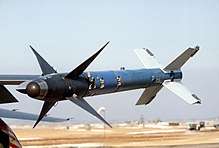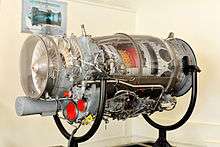British Aerospace Hawk 200
The British Aerospace Hawk 200 is a single-seat, single engine light multirole fighter designed for air defence, air denial, anti-shipping, interdiction, close air support, and ground attack.[2]
| Hawk 200 | |
|---|---|
 | |
| RMAF BAE Hawk 208 | |
| Role | Light multirole fighter |
| Manufacturer | British Aerospace |
| First flight | 19 May 1986 |
| Introduction | 1986 |
| Status | In service |
| Primary users | Indonesian Air Force Royal Malaysian Air Force Royal Air Force of Oman |
| Produced | 1990-2002[1] |
| Number built | 62 |
| Developed from | BAE Systems Hawk |
Development
In 1984, British Aerospace (now BAE Systems) decided to pursue development of a combat-orientated variant of the Hawk aircraft, designated as Hawk 200; up to this point the Hawk family had been typically employed by operators as an advanced trainer with secondary combat capabilities. A single flying demonstrator aircraft was produced to support the development process. This made its first flight on 19 May 1986.[3]
Less than two months after first taking flight, the Hawk 200 demonstrator was lost in a fatal accident, killing BAe test pilot Jim Hawkins; Hawkins is alleged to have either become disoriented or to have fallen unconscious, due to g-LOC (g induced loss of consciousness), while executing high-g manoeuvres to explore the aircraft's agility.
Despite the loss of the demonstrator, the company decided to proceed with the Hawk 200; by 1987, the first pre-production samples were being manufactured.[2] In 1990, the Hawk 200 received its first order when Oman opted to procure a batch of twelve Hawk 203s, all of which were delivered by 1993.[1]
Design
Overview
The Hawk 200 is a single-seat, single engine light multirole fighter with a small visual signature and high maneuverability.[4] It has a low-mounted cantilever wing and is powered by a single turbofan engine. The Hawk 200 differs from the earlier Hawks in the sense that it has a new forward fuselage whereby the forward cockpit area which normally houses a pilot is replaced by an electronics bay for avionics and onboard systems, including a fire control computer, multi-mode radar, laser rangefinder and forward-looking infrared (FLIR).[5] The Hawk 200 also has an upgraded wing, which in addition to four wing pylons seen in previous Hawks, also has wingtip missile support as well as greater wing area, increased wing droop, larger flaps and an optional mid-air refueling capability.[2]
Weapons

The Hawk 200 has 7 external store points with four underwing pylons, an under-fuselage pylon, and wingtip air-to-air missile stations. The range of external stores which the aircraft can carry includes air-to-air missiles (AAM), anti ship missiles (AShM), torpedoes, a gunpod, rocket launchers, reconnaissance pod, retarded and free-fall bombs up to 1,000 pounds (450 kg), runway cratering, anti-personnel and light armour bombs, cluster bombs (meanwhile prohibited), practice bomb and rocket carriers and external fuel tanks.[6]
The Hawk 200 can launch many NATO standard guided missiles including AIM-9L Sidewinder AAM, ASRAAM AAM, AIM-120 AMRAAM AAM, AGM-65 Maverick AGM, Sea Eagle AShM and Sting Ray homing torpedoes.[7] The Hawk 200 can also carry a variety of bombs, including 113 kg bombs, 240 kg bombs, 540 kg bombs and Paveway II guided bombs. The AIM-9L Sidewinder missiles are launched from the wingtip air-to-air missile stations on each wing.
Sensors
The Hawk 200 is equipped with a Northrop Grumman AN/APG-66H multi-mode radar, LINS 300 ring laser gyroscope inertial navigation system, air data sensor, display processor and mission computer. The systems are connected with a dual MIL-STD-1553B digital bus. The Hawk 200 is also equipped with a Ferranti laser rangefinder and a Marconi forward-looking infrared.[1] The self-protection systems include a BAE SkyGuardian 200 RWR[8] and automatic or manual Vinten chaff/flare dispensers located above the engine exhaust.[6]
The AN/APG-66 radar is a solid state medium range (up to 150 kilometres (93 mi)) pulse-doppler planar array radar designed by the Westinghouse Electric Corporation (now Northrop Grumman) for the F-16 Fighting Falcon. It has ten air-to-surface and ten air-to-ground modes for navigation and weapon aiming purposes. The APG-66H variant of the radar is installed on the Hawk 200, which has a smaller antenna for slightly reduced capabilities.
Cockpit
The pilot has a hands-on throttle and stick (HOTAS) control system and a wide-field-of-view head-up display (HUD). Using the weapon control panel, which controls the stores management system, the pilot can select the weapons and release mode prior to initiating an attack.
Like all other modernized Hawks, the Hawk 200's all-glass cockpit has a multi-functional colour display, with a dedicated processor and 15-colour graphics symbology generator. There are 27 display formats which provide flight and aircraft data. The cockpit is also compatible with night-vision goggles.[1][6] Just outside of the cockpit is an inflight refueling probe.
Engine

The Hawk 200 was originally powered by an Adour 871 two shaft, low bypass ratio turbofan engine from Rolls-Royce Turbomeca, providing the aircraft with 26.00 kN of thrust. In 2005, the Adour 951 engine was certified for use on the Hawk 200. The improved Adour 951 has improved performance (rated at 29.00 kN (6,520 lbf) thrust) and has up to twice the service life of the Adour Mk 871. It features an all-new fan and combustor, revised HP and LP turbines, and introduces Full Authority Digital Engine Control (FADEC).
Both engines are non-afterburning versions of the Adour series, and are fed to by air intakes on both sides of the fuselage. The internal fuel tanks are installed in the fuselage and compartmented integral tanks located in the wings, containing up to 1361 kg of fuel. Up to 2 x 591 liter drop tanks can also be carried on the in-board under-wing pylons.[7]
Operational history
Malaysia
On 5 March 2013, amidst the 2013 Lahad Datu standoff, 5 Hawk 208s aircraft, along with 3 F-18D Hornets of the Royal Malaysian Air Force, were deployed in airstrikes on hideouts of the defunct sultanate and terrorist group Royal Security Forces of the Sultanate of Sulu in Lahad Datu, Sabah Malaysia ahead of the ground assault by joint forces of the Malaysian Army and Royal Malaysia Police.[9]
The Hawk 208s flew 15 sorties, each Hawk 200 dropping Mk 82 unguided bombs in the first sortie and firing CRV7 rockets at additional ground targets on the second and third.[10] A spokesman for Malaysian Prime Minister Najib Razak said in a phone interview that the objective of the airstrikes was to "soften the ground before troops move in.”[11]
Variants
- Hawk 203
- Export version for the Royal Air Force of Oman
- Hawk 205
- Proposed export version for the Royal Saudi Air Force
- Hawk 208
- Export version for the Royal Malaysian Air Force; only version equipped with a mid-air refueling probe.[1]
- Hawk 209
- Export version for the Indonesian Air Force
Operators
- Operator figures from flightglobal and[1]
- Indonesian Air Force - 23 in active service. Planned to be replaced by 32 F-16V Block 70/72[12]
- Royal Malaysian Air Force - 13 aircraft left operational from an original of 18
- No. 6 Squadron
- No. 15 Squadron
- Royal Air Force of Oman - 11 aircraft left operational from an original of 12
- No. 6 Squadron
Specifications

Data from [13]
General characteristics
- Crew: 1
- Length: 11.38 m (37 ft 4 in)
- Wingspan: 9.39 m (30 ft 10 in)
- Height: 4.16 m (13 ft 8 in)
- Wing area: 16.69 m2 (179.6 sq ft)
- Aspect ratio: 5.3
- Empty weight: 4,128 kg (9,101 lb)
- Max takeoff weight: 9,101 kg (20,064 lb)
- Fuel capacity: 1,360 kg (3,000 lb) internal: 3,210 kg (7,080 lb) with 3 drop tanks
- Powerplant: 1 × Rolls-Royce Turbomeca Adour Mk 871 non-afterburning turbofan, 26 kN (5,800 lbf) thrust
Performance
- Maximum speed: 1,037 km/h (644 mph, 560 kn) at sea level
- Maximum speed: Mach 1.2 (never exceed at altitude)
- Cruise speed: 796 km/h (495 mph, 430 kn) at 12,500 m (41,000 ft)
- Stall speed: 197 km/h (122 mph, 106 kn) flaps down
- Range: 892 km (554 mi, 482 nmi) internal fuel only
- Combat range: 617 km (383 mi, 333 nmi) with 3x Sea Eagle and 2x 592 l (156 US gal; 130 imp gal)
- Ferry range: 1,950 km (1,210 mi, 1,050 nmi) with 3 drop tanks
- Service ceiling: 15,250 m (50,030 ft)
- g limits: +8 -3
- Rate of climb: 58.466 m/s (11,509.1 ft/min)
- Takeoff distance with maximum weapon load: 2,134 m (7,001 ft)
- Landing distance at maximum landing weight with brake chute: 854 m (2,802 ft)
- Landing distance at maximum landing weight without brake chute: 1,250 m (4,100 ft)
Armament
- Guns: 1 × 30 mm (1.181 in) Aden cannon with 120 rounds
- Hardpoints: Total of 7: 4 × under-wing; and 1 × under-fuselage; and 2 × wingtip with provisions to carry combinations of:
- Other:
- Reconnaissance pod
- Up to 3 drop tanks for ferry flight or extended range/loitering time
- Other:
- Rockets:
- Missiles:
- Air-to-air missiles:
- AIM-120 AMRAAM
- Skyflash
- AIM-132 ASRAAM
- AIM-9 Sidewinder
- Air-to-surface missiles:
- Anti ship missiles:
- Air-to-air missiles:
- Bombs:
- Mark 82 bomb
- Mark 83 bomb
- Paveway II
- BL755 cluster bomb
- Sting Ray torpedo
Avionics
See also
Related development
Aircraft of comparable role, configuration and era
References
- "Fighter-planes". Archived from the original on 2 April 2015. Retrieved 21 March 2015.
- "BAe Hawk Advanced Trainer / Light Strike (1976)". MilitaryFactory.com. Archived from the original on 2 April 2015. Retrieved 21 March 2015.
- Jackson, Paul (2003). Jane's All The World's Aircraft 2003–2004. Coulsdon, UK: Jane's Information Group. p. 481. ISBN 0-7106-2537-5.
- "FoxtrotAlpha". Archived from the original on 20 March 2015. Retrieved 21 March 2015.
- "Hawk 200 faces a tougher market". New Scientist. Reed Business Information (1516): 28. 10 July 1986. Archived from the original on 12 April 2018. Retrieved 1 July 2019.
- "Airforce-technology". Archived from the original on 21 March 2015. Retrieved 21 March 2015.
- "British Aerospace Hawk 100 & 200". MilitaryAviation.eu. Archived from the original on 14 February 2015. Retrieved 21 March 2015.
- "FlightGlobal". Archived from the original on 6 October 2014. Retrieved 21 March 2015.
- "Security forces stay on full alert". New Straits Times. 6 March 2013. Archived from the original on 29 October 2013. Retrieved 6 March 2013.
- "MalaysianMilitary". Archived from the original on 2 April 2015. Retrieved 21 March 2015.
- "smh.com". 5 March 2013. Archived from the original on 25 September 2015. Retrieved 21 March 2015.
- "Alutsista Indonesia on Instagram: "(A.I) Indonesia Menjabarkan Prioritas Pengadaan Militer 2020-2024 Kementerian Pertahanan Indonesia (Kemenhan) telah menggariskan prioritas…"". Instagram. Retrieved 12 December 2019.
- John W.R. Taylor, ed. (1988). Jane's All the World's Aircraft 1988-89. London: Jane's Information Group. ISBN 0-7106-0867-5.